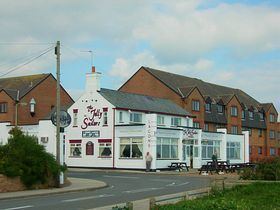Population 6,563 (2011) Dialling code 01502 | Sovereign state United Kingdom Postcode district NR33 7 | |
 | ||
Beach farm holiday residential park in pakefield suffolk
Pakefield is a suburb of the town of Lowestoft in the Waveney District of the English county of Suffolk. Pakefield is located around 2 miles (3.2 km) south of the centre of the town. Although today it forms a suburb of the urban area of Lowestoft, it was until 1934 a village and parish in its own right. Pakefield lies along the North Sea coast. The former parish church, All Saints and St Margarets, is located on the coast.
Contents
- Beach farm holiday residential park in pakefield suffolk
- Map of Pakefield Lowestoft UK
- History
- Coastal erosion
- Governance
- Modern Pakefield
- Notable people
- References
Map of Pakefield, Lowestoft, UK
Pakefield became a site of national archaeological importance in 2005 when flint tools over 700,000 years old were unearthed. This was the oldest evidence of human occupation anywhere in the UK, until flint tools at least 800,000 years old were discovered further up the coast at Happisburgh in 2010.
Pakefield has boundaries with Carlton Colville and Kirkley, both also districts or suburbs of Lowestoft. It forms the southern boundary of the Lowestoft urban area with Kessingland about 2 1⁄2 miles (4.0 km) to the south.
History
Pakefield is the site of one of the earliest known areas of human habitation in the United Kingdom. In 2005 flint tools and teeth from the water vole Mimomys savini, a key dating species, were found in the cliffs. This suggests that hominins can be dated in England to 700,000 years ago, potentially a cross between Homo antecessor and Homo heidelbergensis.
Bloodmoor Hill, between Pakefield and Carlton Colville, was the site of settlement in the 2nd and 3rd centuries and the 7th and 8th centuries. The Saxon period consisted of a relatively dense settlement as well as a cemetery which included at least one rich barrow burial. Artefacts were discovered at the site in the 18th Century and the Saxon cemetery site was the subject of archaeological investigations between 1998 and 2006.
In the Domesday book Pakefield is called "Pagefella", the name probably coming from the Pagan settlement name of Pagga's or Pacca's field. The village was part of the King's holdings and was part of the Hundred of Lothing. It had a population of about 17 households, including a number of freemen. Part of the tax payment made by the village was 600 herrings.
Pakefield later developed as a fishing community. The former terminus of the Tram Service from Lowestoft is located in the centre of Pakefield and is now the site of the Tramway Hotel. In the modern era, the area played an important role in the Kindertransport programme nine months before the start of World War II. Many children who had not found prearranged foster families were given temporary shelter in the local holiday camp.
Coastal erosion
Coastal erosion has been an issue in the area for a number of years, although this may have begun to stabilise. A former lighthouse still stands on the coastline and is used by Pakefield Coastwatch.
The map image below shows how erosion occurred between 1882 and 1955. The photos show the extent of the erosion and damage to property which occurred.
Governance
Pakefield sends two councillors to Suffolk County Council and Waveney District Council. The Member of Parliament is elected through the Waveney seat which. For county council elections Pakefield is part of a larger constituency with the neighboring suburb of Carlton Colville.
Modern Pakefield
The coast is an important tourist destination with a number of holiday destinations, including a Pontins holiday camp. In November 2010 Pontins entered administration, being taken over by the Brittania Hotel Group.
The area has a number of local shops and businesses, including The Seagull theatre and cinema. As well as the church of All Saint's and St Margaret's, Pakefield has a catholic church dedicated to St Nicholas.
It also has a primary school and a high school. The primary school was awarded a grant by the Royal Society in 2009 to develop a project called 'What has the sea ever done for us'. Pakefield School opened in September 2011 as part of a reorganisation of education in Lowestoft. This involved the closure of Pakefield Middle School and an extension of the primary school to take children up until the end of year 6. The high school took over the middle school site and buildings.
The Promoting Pakefield Group was formed in 2004 to attempt to promote the area and its interests. A variety of local improvements have been made, including providing a Christmas tree, noticeboards and making improvements to the local war memorial. The group is made up of a number of local businesses and other organisations.
Notable people
The author and illustrator Michael Foreman was born in Pakefield in 1938 and attended Pakefield Primary School. He has written about Pakefield in his books.
